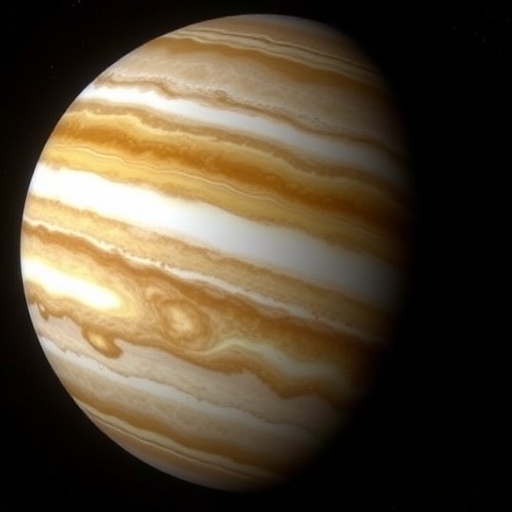Four and a half billion years ago, our solar system was a chaotic place. At the center of this cosmological maelstrom sat a young Jupiter, rapidly accumulating mass and exerting a gravitational influence that would alter the course of planet formation. This monumental growth led to the disruption of orbits of small, rocky, and icy bodies known as planetesimals, which are considered the building blocks of the planets we see today. These planetesimals often collided with one another at high velocities, resulting in catastrophic impacts that caused the materials they held to melt and subsequently cool, forming small, spherical structures known as chondrules. These tiny droplets of molten rock are key to understanding the intricate history of our solar system.
Recently, a multi-institutional team composed of researchers from Nagoya University in Japan and the Italian National Institute for Astrophysics has made significant strides in illuminating the formation process of these chondrules. Their groundbreaking study, published in Scientific Reports, offers new insights into the relationship between Jupiter’s emergence and chondrule development. For the first time, they have accurately determined the conditions that led to the formation of these tiny structures, which are often found preserved within meteorites that have fallen to Earth. This research adds another layer of complexity to our understanding of planetary formation, highlighting the role of water in shaping the characteristics of chondrules and, consequently, the planets themselves.
Chondrules are intriguing celestial objects, measuring approximately 0.1 to 2 millimeters in diameter. Their round shape has puzzled scientists for decades, with various hypotheses proposed over the years to account for their formation. The new research presented by the team suggests that as planetesimals collided with each other, the temperature and pressure generated vaporized any water present, turning it into rapidly expanding steam. This process acted like miniature explosions that fragmented the molten silicate rocks into small droplets, which eventually cooled to form the chondrules observed in meteorite samples today. This represents a significant advancement in our understanding of chondrule origins as it aligns their characteristics with the environmental conditions prevalent during the formation of the solar system.
The implications of this research extend beyond chondrules alone. The team utilized sophisticated computer simulations of Jupiter’s growth, meticulously tracking the high-speed collisions among rocky, water-rich planetesimals that characterized the early solar system. These simulations demonstrated that the conditions necessary for the formation of realistic chondrules emerged naturally as Jupiter amassed its mass. Remarkably, the simulations also revealed that chondrule formation coincided with Jupiter’s intense accumulation of gas from the surrounding nebula. This timing is crucial, as meteorite data suggests that chondrule production peaked only 1.8 million years after the solar system began to form, marking a pivotal moment in the birth of Jupiter itself.
One of the fascinating aspects of the study is its ability to provide a clearer framework for understanding the chronology of planetary formation. While it identifies a direct link between the formation of Jupiter and the production of chondrules, it also acknowledges that the formation of these droplets was likely a brief phenomenon. This limitation introduces an intriguing complexity: if chondrules existed in various ages within meteorites, it suggests that other giant planets, such as Saturn, may have also played a role in triggering chondrule formation during their respective births. Thus, studying the ages of chondrules can serve as a cosmic timeline, allowing scientists to trace the order in which the planets formed and to better comprehend the dynamic processes that shaped our solar system.
The findings from this research not only enrich our understanding of our celestial neighborhood but also offer valuable insights into the formation processes of planetary systems beyond our own. The study’s methodology, which encapsulates computational simulation and extensive modeling, highlights the potential for researchers to apply similar approaches when investigating the birth of other star systems scattered across the universe. These insights may pave the way for breakthroughs in exoplanetary science, where understanding the origin of fundamental building blocks, such as chondrules, could be pivotal in grasping the nature of habitable worlds elsewhere in the cosmos.
In summary, the recent findings surrounding chondrule formation due to Jupiter’s influence unravel a complex narrative about the origins of our solar system. The researchers’ ability to connect the evolutionary threads of chondrules with the colossal gravitational forces exerted by Jupiter provides a holistic view of planetary formation processes. This knowledge is not merely academic; it resounds with implications for the study of planetary systems beyond our own, suggesting that the violent and chaotic processes seen in our solar system may be prevalent throughout the galaxy.
As our understanding of the formation of chondrules continues to evolve, ongoing research will undoubtedly shed further light on the intricate dance of celestial bodies that led to the creation of our home planet and its neighbors. This research serves as a reminder of the dynamic history enshrined in the rocks that litter our planet, connecting us to a time long before life emerged on Earth. Each meteorite that falls carries with it a fragment of that ancient past, a testament to the chaotic beauty of the universe’s formation.
By further exploring the conditions that allowed for the varied ages of chondrules present within meteorites, we can better appreciate the rich tapestry of cosmic history that surrounds us. From the early explosions of steam-driven impacts to the gradual evolution of planets, these insights underscore the importance of chondrules as both geological and astronomical time capsules that help scientists piece together a unified story of our solar system’s birth and evolution.
Subject of Research: Chondrule formation and its relationship to Jupiter’s growth
Article Title: Chondrule formation by collisions of planetesimals containing volatiles triggered by Jupiter’s formation
News Publication Date: August 25, 2025
Web References: Scientific Reports
References: None Available
Image Credits: Akira Miyake, Kyoto University
Keywords
Jupiter, chondrules, planetesimals, solar system formation, meteorites, astronomical simulations, planetary evolution, cosmic history, water in planetary formation, exoplanetary science, celestial structures.




